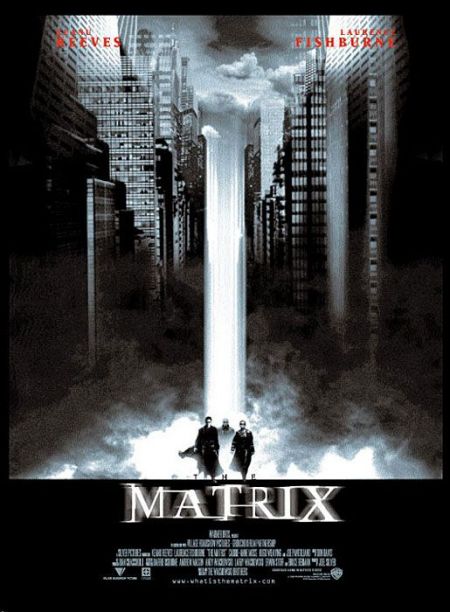- Comics
- Comics Reviews
- Manga
- Comics Reviews
- European Comics
- News
- Comics News
- Press Releases
- Columns
- Spotlight
- Digital Comics
- Webcomics
- Cult Favorite
- Back Issues
- Webcomics
- Movies
- Toys
- Store
- More
- About
By Andy Frisk
March 28, 2009 - 23:44
On March 31st, 1999 The Matrix opened in

Variant poster.
I remember the teaser trailer for The Matrix that debuted during the Super Bowl that year, in fact I remember it more vividly that which teams were playing. I was at a Super Bowl party and remember having a few beers (since the Pittsburgh Steelers weren’t playing in the game I didn’t really care who was winning), and generally having a good time with some friends from college and work when the teaser trailer came on. I had heard something somewhere about this new Keanu Reeves flick and remembering Bill and Ted's Excellent Adventure (1989), and more recently from my high school years Point Break (1991) and Speed (1994), I figured it’d be pretty good. The girls I dated at the times those films were out just “had to see Keanu because he’s sooo cute!” Of course I ended up enjoying the films as well because they were either funny or were decent action flicks.
When I saw the trailer for this film though I realized that it was going to be something much bigger than a decent action flick, simply from the snippet of the “bullet time” bullet dodging scene we were treated to.

Eagerly anticipating the release of The Matrix, I couldn’t wait for its opening day. I remember getting my ticket and seeing it for the first time on the evening of its opening day. Of course the biggest and most interesting special effect was the use of bullet time by John Gaeta and his crew of special effect artists. The innovative use of this technique created new perspectives for the film's viewers that proved as fascinating as the story in The Matrix was itself. The famous scene where Neo attempts to dodge an Agent’s bullets during a rooftop showdown gave its viewers a perspective hitherto unseen in a major motion picture. Beyond the visual ground being broken with the film's special effects, a new way of viewing perspective on film was being born. With bullet time, the audience is now taking in a single event from all angels of perspective nearly at once as the action unfolded. It was a subtly powerful way to provide a metaphorical and psychological analogy for Neo’s awakening mind. In order to be “The One,” Neo had to see the code, or the entire picture behind the scenes, which would allow him to encapsulate all time as one moment in order to dodge bullets moving at incredible speeds (he wasn’t fully The One yet), and later to stop bullets in mid air (after being reborn as The One). The visual image of the moment Neo dodges the bullets created through the use of bullet time gives the audience a glimpse at just what Neo is attempting to do, namely see a moment in time all at once from all angels at once, and bring it to a near halt in order to get out of the way of certain death.

No one can be told what The Matrix is. It must be shown.
The use of bullet time in The Matrix was so visually engaging that it started popping up everywhere one looked on the TV and on other films. Toshiba created a “Matrix Inspired Time Sculpture” ad which utilized the principles of The Matrix-style bullet time as seen here. Some argue though that the 1998 “Gap Swing” ads, as seen here, inspired the use of bullet time in the film. Either way, the use of bullet time in The Matrix captured, while spreading to a wider audience, the zeitgeist happening in visuals at the time. Other films incorporated elaborate uses of bullet time as well, including Swordfish (2001), starring Hugh Jackman, which used bullet time in its opening sequence. It also pretty quickly got parodied in various comedy films like Scary Movie.

"You're saying I can dodge bullets?"
Along with the film's special effects and visuals, the amount of philosophical, post-modern and religious themes and theories utilized by the film’s plot proved to be just as engaging. We find out what The Matrix is in the same way Thomas Anderson/Neo does. We cannot be told what it is; it has to be shown, to paraphrase Morpheus. For many individuals, with whom I’ve spoken with, who enjoyed the film, and some who didn’t enjoy the film, this slow revealing trip we take with Neo from the dream world to the “real” world (ironically referred to as such by Morpheus who pointedly asks Neo “What is real? How do you define real?”) was the aspect of the film's plot that was the most captivating. The revelations about what The Matrix is are conveyed in an incredibly powerful way by taking the movie watcher on a trip of discovery solely bound by the perspective of its protagonist. Going “further down the rabbit hole,” as Morpheus refers to Neo’s journey of discovery, the film itself goes philosophically deeper than just the shock of the revelation that the world around him is not "real." We immediately are drawn to the philosophical dialogue reminiscent of the analogy of Plato’s Cave and its relevance to the world of The Matrix and the real world. As the film progresses, and we discover that The Matrix is a “computer generated dream world” generated by a race of machines in order to enslave mankind, the image of Descartes’ brains in a vat theory, and the more sinister idea of the “malicious demon” who has, like the machines of The Matrix, generated an illusion that we perceive to be the world around us in order to manipulate us, comes to mind. This was obviously an inspiration to the Wachowski’s, the films writers and directors. Another, and greater, influence on the Wachowski’s was French philosopher Jean Baudrillard's Simulacra and Simulation. In this groundbreaking philosophical work, Baudrillard's “claim is that we now live –and he says this is something new, part of the current historical period known as ‘postmodernity’- in an imitation world, a highly artificial world of images, signs, copies, and models in this high-tech, computerized world of virtual reality and media saturation, the idea of a ‘real’ world underlying the dizzying parade of images and simulations has dropped out of sight” (Irwin 94) can be seen everywhere in The Matrix's plot. Baudrillard argues that the world around us is nothing but a simulation, and meaning is either lost or totally insignificant since it is the image that is of the foremost importance. The Matrix program, and its dominance of sign (dream) over signifier (awareness) is the Wachowski’s brilliant metaphor for this real world philosophy. All of these philosophical theories, and their relationship to the film, are explained way better than I ever could explain in their source works as well as in the many works written about The Matrix and its sequels. I include a list of them at the end of this article. All of them are wonderful reads, and definitely worth checking out.

Showdown.
The Matrix has many, many, religious themes as well as philosophical ones. As I mentioned at the outset of this article, it was no small coincidence that the film opened the Wednesday before Easter. Neo’s character can easily be seen as Christ-like in that has to die and be reborn in order to save humanity. He also travels a path much like that traveled by The Buddha though. Neo's journey is one of enlightenment and much as it is one of sacrifice. There's also a strong current of Gnosticism that runs through the films. The humans must, in order to free their minds, realize that the world they see all round them is illusory and imperfect. They must awaken to the knowledge of this in order to see the truth of their situation and learn how to manipulate it to meet their ends of revelation. Like one of the child “potentials” (those who might be The One due to their ability to see beyond the illusionary world of The Matrix program) states to Neo (in the Oracle’s living room while “bending” spoons with his mind) “Do not try to bend the spoon. That’s impossible. Instead try to realize the truth.” “What truth?” Neo responds.“That there is no spoon.” answers the potential.

"Take the red pill and you stay in wonderland and I show just how deep the rabbit hole goes."
The truth about The Matrix, like all films, novels, poems, paintings, sculptures, and comic books that are possessed of a depth of intelligence, is that all of them have at their core a truth, a metaphor or lesson that enlightens the intellect and raises the consciousness of its reader or viewer. The Matrix gives us a powerful metaphor for the struggle of everyday life. No, we are not living in a dream world controlled by a malicious outside demon or machine (although for Descartes and his students that argument may not be settled). We, though, ARE faced with obstacles and systems that have been put in place to hold us back, hold us down, or simply lull us into complacency. We also though have the power slough off these systems of control IF we use our intellect and will to affect the change in our lives and environments that is necessary to beneficially raise our standards of thought, love, and life. Part of this sloughing off of control is to simply stand up to our own inadequacies and fears. We can overcome whatever it is in our lives that imprisons us, and help others who are struggling to be free from bigotry, racism, poverty or ignorance by believing in the power of ourselves and the goodness to which not all, but most of us, respond to. When faced with a challenge, I like to think of the simple little phrase that was taught to Neo by a child: "There is no spoon." Then I attempt to forge ahead and discover the truth at the heart of the problem or challenge, and in time master it. It is this empowering message of The Matrix that, to me, makes the film and its sequels true works of art. These films collectively attempt to raise the consciousness of their viewers.

Neo "sees the code."

Rare movie poster.
For much better explanations of the many ideas and philosophies so poorly recapitulated by my meager explanatory skills in this article, check out the following books and many others to long to list here:
Philosophers Explore The Matrix.
Edited by Christopher Grau
The Matrix and Philosophy and its sequel More Matrix and Philosophy. Edited by William Irwin
Matrix Warrior: Being the One.
By Jake Horsley
Beyond The Matrix: Revolutions and Revelations.
By Stephen Faller